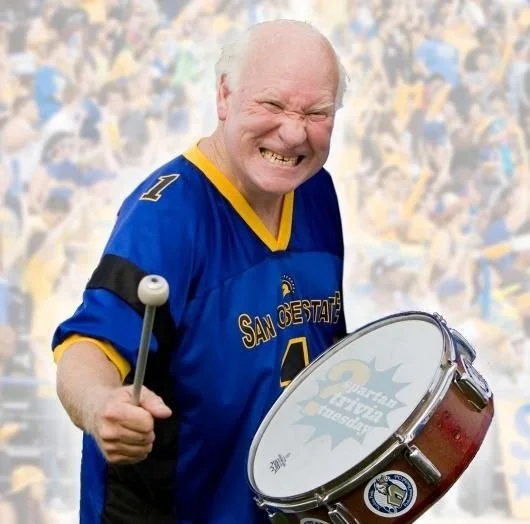WAVE THEORY
“The future belongs to crowds.” — Don DeLillo
OAKLAND COLISEUM, OCT. 15, 1981 — Down two games in the playoffs, the A’s are facing a sweep. Then from just off third base, something new in sports, in human behavior, erupts.
Thousands of fans rise, lift their arms, then sit. The motion spreads. Section after section stands, waves, sits, sending a great human wave around the stadium. On the field, players stop and watch. The announcers are stunned. NBC cameras leave the field and follow the action in the stands.
“Get it!” a director tells a cameraman. “Get that thing!” After a few minutes, the crowd settles. The A’s lose, ending their season, but The Wave has come to America. Next stop: the world.
Like folk songs and Dad jokes, The Wave might seem to have no creator. People just started standing. Fun. Crazy. But that second word should be spelled with a K, because while many claim they were present at the creation, the certified inventor of The Wave is Krazy George.
George Henderson was just another amped up sports fan until he went to San Jose State in the late 1960s. There he began leading cheers at football games, pounding on a drum, screaming himself hoarse. George soon took his enthusiasm into classrooms, teaching high school but leading cheers on weekends.
By the mid-1970s, his zany antics and contagious enthusiasm got George a job cheerleading for the Kansas City Chiefs. A career was born, but he never set out to start a wave. That was an accident.
At hockey games, where crowds are smaller, George started getting one side of the arena to jump and cheer, then shifted to the opposite side. But one night in Denver, one section delayed its jump. The adjacent section followed spontaneously. Then the next, and a wave circled the arena.
George soon perfected the timing. “It’s amazing what you can do with the confinement of the fans in a hockey arena,” he growled. “The secret is the curve around the rink. It lends itself to great momentum because you can see the wave coming and there’s anticipation.” By 1981, The Wave was set for its major league debut.
“In the third inning I thought I would try this thing that no-one had seen before. I found three sections and started explaining what I wanted." Initial attempts broke down but George got crowds to boo reluctant fans. On the third attempt, The Wave circled the Coliseum. Soon “the place was going nuts.” Watch.
So that’s how it began. Or was it?
While George was cheering in San Jose, Robb Weller was a cheerleader for the University of Washington. When crowds were bored, Weller tried a trick to wake them up. Everyone at the back of the section stand and wave. Then those in front of them. Then further down. A vertical wave.
Fast forward to 1981. It’s Halloween and Weller is back for homecoming. Asked to lead a cheer, he gets people going, this time around and around Husky Stadium. Weller insisted he had not seen Krazy George’s wave two weeks earlier. “I hate baseball,” he said. But The Wave became a staple at the university, leading to dueling creation myths.
"Their theory is that they came up with it in 30 seconds!” scoffed Krazy George. “'Oh, we just thought it up.'”
The Wave might have stayed in Oakland and Seattle but waves are forces of nature. In 1983, after Huskies football hosted the University of Michigan, The Wave debuted in Ann Arbor. The following summer, it came to Tiger Stadium in Detroit and when the Tigers won the World Series, The Wave began popping up across America. Then came the World Cup.
In 1986, with the whole world watching, soccer-sated crowds in Mexico City waved and waved. When “The Mexican Wave,” aka la Ola, began sweeping the globe, neither Krazy George nor Robb Weller were surprised.
“I’ll tell you what happens,” George rasped to ESPN. “Energy! Once the wave starts, people get revved up!” Weller agreed. “It makes people feel connected and gives people some sort of power in the stands, where really you’re powerless. It makes you feel you can affect something.”
The Wave was everywhere in the Eighties. In “When Harry Met Sally,” Harry and a friend converse while standing every 30 seconds. In “Field of Dreams,” Kevin Costner and his daughter do a two-person wave. But by the Nineties, The Wave seemed passé, the plaything of so-called “fans” who didn’t care about the game.
Yet something in The Wave seems so natural, so human. In 2002, the British journal Nature agreed, publishing a study by a Hungarian professor. Analyzing 14 waves at huge stadiums in Mexico, Tamás Vicsek saw mathematical patterns similar to those in forest fires and the beating of the human heart. Stadium waves, Vicsek found, always travel clockwise. Speeds average 27 miles per hour. And in the absence of a cheerleader, a wave started by “no more than a few dozen people standing up simultaneously. . . expands through the entire crowd as it acquires a stable, near-linear shape."
George Henderson, now 80 and still cheering, is as krazy as ever. The Wave is not so common, yet it has spawned variations, including a Silent Wave, a Shsh Wave of shushing fans, and the Bounce Wave that starts at opposite ends of a stadium and washes over itself. George doesn’t care what kind of wave you ride, so long as he gets the credit.
“It’s like the guy who invented the paper clip. He’s walkin’ around, no one knows him, it’s just a a little clip on a piece of paper. He’s happy, just a personal little thing. My claim to fame. Like the paper clip.”









